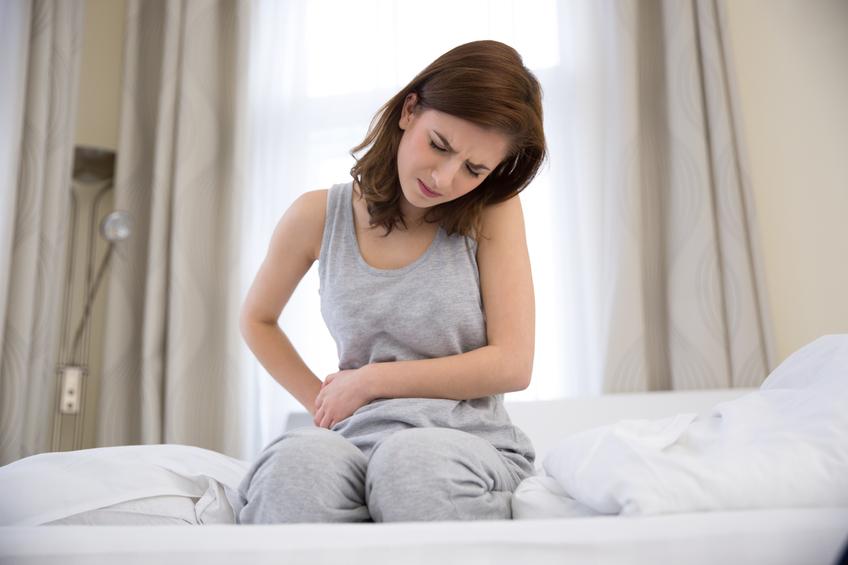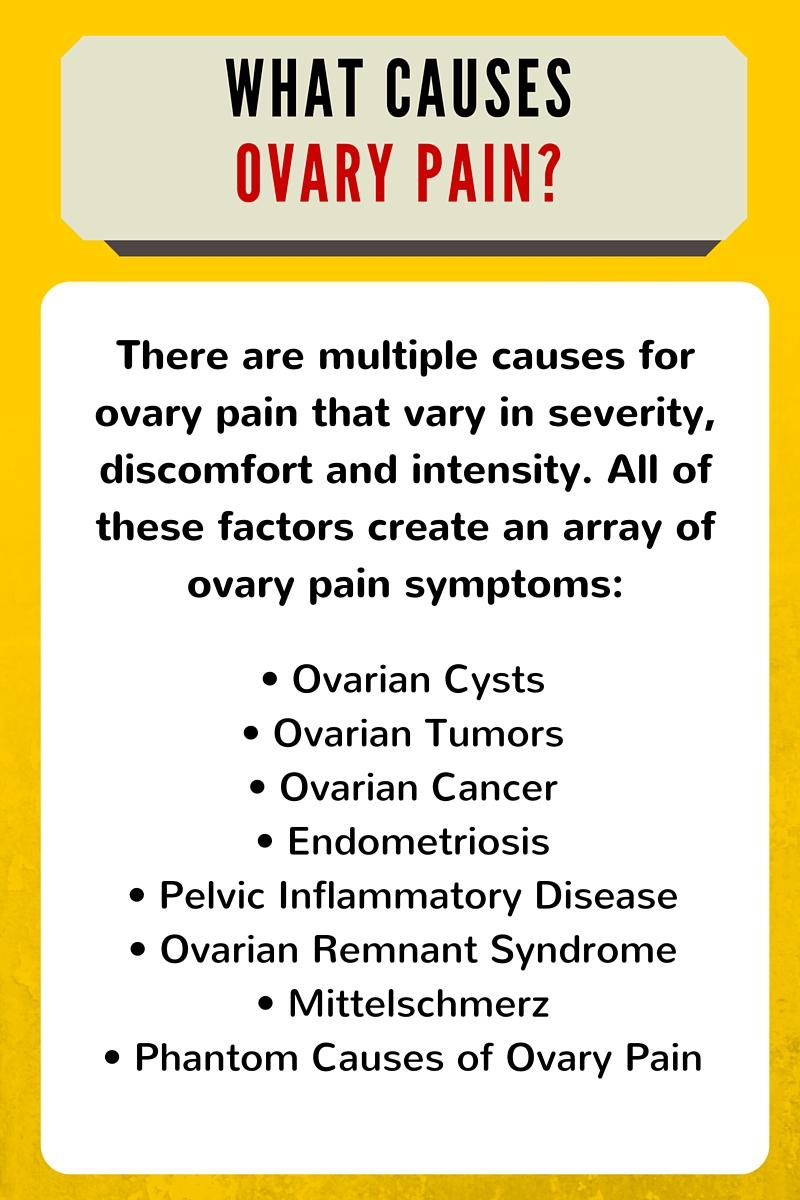 Whether you have a sharp pain in your ovary or experience dull aching ovaries, any pain in the area can be uncomfortable and a cause for concern.
Whether you have a sharp pain in your ovary or experience dull aching ovaries, any pain in the area can be uncomfortable and a cause for concern.
There are a number of causes of ovary pain (1). The ovaries, located in the lower abdomen, serve a number of central purposes for women, and are key parts of the reproductive system.
They are responsible for releasing one egg each month that can be fertilized, while also producing hormones such as estrogen, which trigger menstruation.
Why Do My Ovaries Hurt?
There are multiple causes for ovary pain that vary in severity, discomfort and intensity. Pain can be dull or sharp, can quickly set in or build slowly, or be acute or chronic. It can be the result of cysts, tumors, infections, and more, and sometimes you may even mistake lower abdomen pain for pain in your ovaries. All of these factors create an array of ovary pain symptoms.

Ovary pain symptoms are felt in the lower abdomen between your belly button and pelvis. Sometimes you may hardly notice them while other times they can affect your quality of life or create the fear that they might be causes of ovary cancer.
Ovary pain might only occur during certain instances, such as during menstruation, going to the bathroom, or exercising. Because ovary pain can be caused by such a wide variety of conditions, it’s advised to get any pelvic pain examined by a doctor.

Ovary Pain Causes Explored
1. Ovarian Cysts
Ovarian cysts are fluid-filled sacs and are a common cause of ovary pain. They typically affect women during their childbearing years, as they are usually a result of ovulation. Causes of ovary cysts include the egg not being released, or the sac (follicle) that holds the egg not properly dissolving after letting go of the egg. Sometimes this causes ovarian cyst pain, but the majority of ovarian cysts do not result in pain and dissolve on their own. The pain can take the forms of a dull ache or a sharp, intense pain if the cysts twist or rupture. Ovarian cysts can lead to other symptoms such as:
- Irregular periods;
- Pain during intercourse or bowel movements;
- Nausea;
- Vomiting;
- Feelings of fullness after eating only a small amount; and
- Bloating.
Ovarian cysts can be diagnosed by your doctor through a pelvic exam or ultrasound.
2. Ovarian Tumors
Tumors can form in the ovaries just like anywhere else in the body, and they can lead to aching ovaries and are a cause of ovary pain after menopause. And also like all other tumors, ovarian tumors can be noncancerous (benign) or cancerous (malignant). Aside from causing ovary pain, symptoms include:
- Bloating or pressure in the abdomen;
- An urgent need to urinate;
- Indigestion;
- Diarrhea;
- Constipation;
- Little or no appetite; and
- Unintended weight loss or weight gain.
Ovarian tumors and ovarian cancer can be diagnosed in a few different ways. The best ways to find them are through advanced imaging techniques such as CT scans, MRIs, or PETs. A blood test called a CA-125 can also be conducted, but it’s not a good indicator of whether or not you have ovarian cancer.
3. Ovarian Cancer
Ovarian cancer can also be a source of pain in the ovaries. It’s responsible for about three percent of all cancer cases in women, and the Centers for Disease Control and Prevention reports that 90 percent of those who contract it are over 40, with the majority of those over 60. A tumor can be a main cause of ovary pain after menopause, however it may not signify cancer; as mentioned above, it’s possible to have ovarian tumors that are benign.
4. Endometriosis
This happens when the tissue that normally lines the inside of the uterus ends up growing outside of it. Endometriosis can be a major cause of ovarian pain during menstruation, when this tissue is shed. It can lead to repeated bouts of pain in the ovaries during periods and ovary cramps because scar tissue can form, which causes ovulation pain each month as the area becomes increasingly sensitive. Other symptoms of endometriosis include:
- Painful periods;
- Pain during intercourse;
- Heavy periods; and
- Infertility.
Endometriosis can be diagnosed via ultrasound, MRI, or laparoscopy.
5. Pelvic Inflammatory Disease
Pelvic inflammatory disease is an infection of the ovaries, which can also affect the uterus and Fallopian tubes, commonly resulting in pelvic pain. It’s usually caused by sexually transmitted diseases such as chlamydia or gonorrhea, which can spread to an ovary infection. Aside from feeling a sharp pain in the ovaries, or even a dull nagging pain, other signs of pelvic inflammatory disease include:
- Pain during intercourse;
- Fever;
- Vaginal discharge that may have an odor;
- Irregular menstrual bleeding;
- Diarrhea;
- Vomiting;
- Fatigue; and
- Difficulty urinating.
Pelvic inflammatory disease can be diagnosed by a pelvic exam, blood tests, urine tests, ultrasound, or laparoscopy.
6. Ovarian Remnant Syndrome
Sometimes surgery is needed to remove the uterus or ovaries. These procedures are known as hysterectomies and oophorectomies, respectively. In rare cases, it’s possible that a piece of the ovary is accidentally left behind and can grow, which can cause ovarian cyst pain. Ovarian remnant syndrome is one of the causes of ovary pain after ovulation and after menopause. Other symptoms of this condition include:
- Pain during intercourse; and
- Difficulty urinating.
It’s diagnosed using an ultrasound, CT scan, or MRI.
7. Mittelschmerz
Mittelschmerz can be a cause of left ovary pain. It’s a one-sided pain in the lower abdomen that’s caused by a ruptured follicle during ovulation. One of the causes of ovulation pain, this condition can also cause pain in the right ovary. In fact, it can affect either side of your abdomen, affect the same side repeatedly, or move back and forth. This happens during menstruation and can create a sharp pain in the ovaries lasting anywhere from a few minutes to a few hours. It can also appear as a dull pain.
8. Phantom Causes of Ovary Pain
Not every pain in the lower abdomen is attributable to pain in the ovaries. Sometimes it’s completely unrelated, and can come from a variety of sources. Appendicitis pain occurs in the lower abdomen, while other causes may arise from other issues in the reproductive system. There can be pain in the area, on the left or right sides, and may be a result of:
- Kidney stones;
- Bladder infection;
- Urinary tract infection;
- Uterine fibroids;
- Gall bladder infection; or
- Constipation.
The causes of ovary pain are numerous, and are best diagnosed by a doctor—without the proper equipment, it’s very difficult to accurately diagnose the reasons for ovary pain. Regardless of age, type of pain, or when the ovary pain occurs (e.g., during ovulation or afterward), the best thing to do is make an appointment with an obstetrician or gynecologist to get to the root of the problem.
Read Next:
